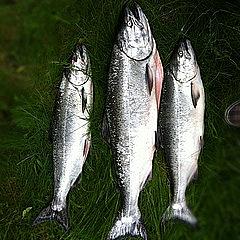The seafood diet: Healthy or dangerous?

Salmon. Photo by kris krüg
Let us eat fish, say the newest guidelines from the Food and Drug Administration and the U.S. Environmental Protection Agency. This June, for the first time, the agencies set minimum dietary recommendations for seafood, at least 8 ounces per week for pregnant women and two to three small weekly servings for young children. But eating fish has long presented a quandary. Nearly every fish swimming in American waters is tainted with some level of mercury.
On the Pacific Northwest coast, seafood is often the best healthy protein available for dinner—especially in some remote tribal communities, where the main alternative might be canned and boxed meals and sugary snacks from convenience stores. Subsistence fishing is at the center of tribal traditions and history here, and in recent years, fish-eating has become part of a cultural movement, including the revival of salmon feasts and ceremonies. Eating seafood—which is full of omega-3 fats—is an antidote to problems like diabetes and heart disease that have become rampant in tribal communities.
But Northwest fish live in waters that bear the wastes of industries and contamination carried by rainstorms—everything from paint chemicals and pesticides to motor oil. Eat more fish more often, and you may get a regular dose of pollution, putting you at greater risk for cancer, neurological problems, and liver disease. According to the Washington State Department of Health, American Indians and Alaska natives have higher rates of diseases like colorectal cancer—which can be linked to both diet and exposure to pollution—than the state’s white population.
Moreover, shellfish are prone to several other kinds of health threats that can make them altogether inedible: They accumulate toxins produced by certain species of algae, a problem known as shellfish poisoning. They can also be contaminated by fecal bacteria from farm animal manure and leaking septic tanks. State agencies regularly close contaminated shellfish beds.
Many of these environmental problems will likely get worse as the Northwest’s population swells. Some will be compounded as Pacific Ocean waters warm. For the National Health Journalism Fellowship, I will focus my reporting on Washington state. Here tribes have long pushed for more stringent water quality standards, but last spring, reports emerged that companies like Boeing pressured Washington state agencies to hold off on updating regulations for toxic water pollution. The current regulations are based on a depressed estimate of the amount of fish that state residents consume—about six and a half grams per day per person (a little over an ounce and half per week), some of the least stringent guidelines in the nation. Some native communities here eat more than 200 grams of seafood per day (about 50 ounces per week). Both tribes and environmental groups say current standards aren’t enough to keep the public safe and the water clean. Alarmingly, this past December, China banned shipments of Northwest shellfish, in part because officials there said commercially harvested saltwater clams from Washington tested high for arsenic.
In the coming weeks, the state is likely to propose new water quality standards, which will renew public debate about how to protect coastal waters. I see the struggles of tribes in the Northwest over fish and pollution as a case study of the pressures that are affecting coastal ecosystems around the country. Tribes are at the center of a crisis affecting our coasts, and they have been some of the most vocal advocates for water-quality standards. Their health and culture are at stake, first and foremost. But what happens to coastal waters will ultimately affect America as a whole.
